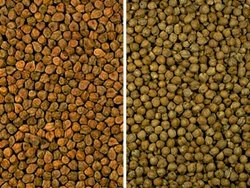Chickpea
|
|
| Chickpea | ||||||||||||||
|---|---|---|---|---|---|---|---|---|---|---|---|---|---|---|
| | ||||||||||||||
| Scientific classification | ||||||||||||||
|
The chickpea, garbanzo bean, ceci bean or bengal gram (Cicer arietinum) is an edible pulse of the Leguminosae or Fabaceae family, subfamily Faboideae or Papilionoideae.
The plant is 20-50 cm high and has small feathery leaves on both sides of the stem. One seed-pod contains 2-3 peas. The flowers are white or reddish blue. Chickpeas need a warm climate and more than 400 mm annual rain.
| Contents |
Etymology
The name chickpea derives eventually from the latin name cicer through the french chiche. The name Cicero is derived from this plant.
Varieties
Several dozen distinct chickpea varieties are cultivated. European varieties are large (typically around 15 mm diameter) and most commonly pale yellow. There were several other varieties, with black and reddish seeds that are rarely grown today. The black variety was mainly used as fodder. Asian varieties are smaller (typically 5-8 mm) and dark brown in color. The chickpea is not known in a wild state. It is grown in the Mediterranean, western Asia and India. In India the plants are eaten as salad as well.
Uses
Chickpeas can be eaten in salads, cooked in stews, ground into a flour called gram flour (also known as besan, and used in Indian cuisine), ground and shaped in balls and fried as falafel, cooked and ground into a paste called hummus, or roasted and spiced and eaten as a snack. The plant can also be used as a green vegetable.
History of cultivation
Domesticated chickpeas are first known from the aceramic levels of Jericho (PPNB) and Cayönü in Turkey and the pottery neolithic Neolithic in Hacilar, Turkey. They are found in the late Neolithic in Thessaly, at Kastanas, Lerna and Dimini at ca. 3500 BC. In the southern French cave of L'Abeurador Dept. Aude chickpeas have been found in Mesolithic layers, dated to 6790+90 BC with the radiocarbon method.
By the Bronze age they were known in Italy and Greece. In classical Greece, they were called erébinthos, and eaten both as a staple and as dessert, raw when young. The Romans knew several varieties known, for example venus-, ram- and punic chickpeas. They were eaten as a broth and roasted as a snack. The Roman gourmet Apicius gives several recipes for chickpeas. Carbonised chickpeas have been found at the Roman legionary fort at Neuss (Novaesium), Germany in layers of the 1st century AD, as well as rice.
Chickpeas are mentioned in Charlemagne's Capitulare de villis (ca. 800 AD) as cicer italicum, to be grown in each imperial demesne. Albertus Magnus knows three varieties, red, white and black. According to Culpeper "chick-pease or cicers" are less "windy" than peas and more nourishing. They are under the dominion of Venus and have a number of medical uses: they increase sperm and milk, provoke menstruation and urine and are helpful against kidney stones. The wild cicers were thought to be especially potent.
Chickpeas were grown in some areas of Germany up to the WW1, afterwards they were used as ersatz coffee.
Trivia
It has been suggested (among other explanations) that the chickenpox disease gets its name from chick peas, which resembled the chickenpox blisters that appeared on the skin.
See also
de:Kichererbse fr:Pois chiche ja:ヒヨコマメ pt:Grão-de-bico sv:Kikärt wa:Poes d' souke

